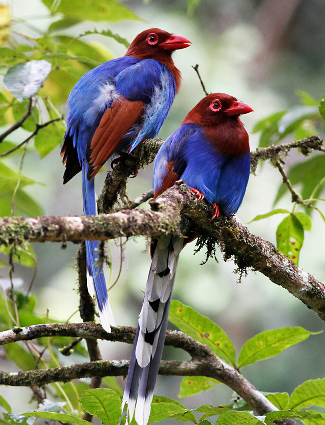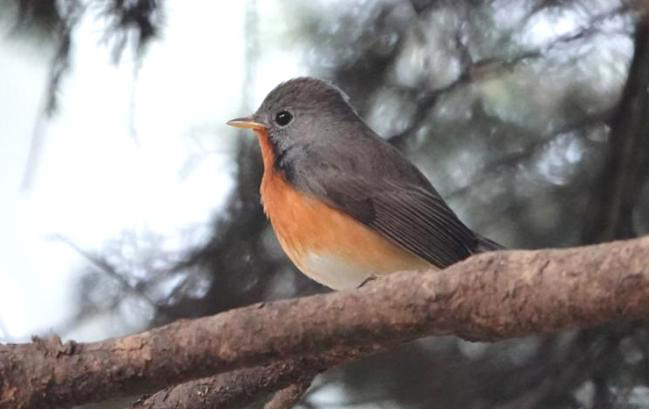

A pair of endemic Sri Lanka Blue Magpies by Chris Townend.
- Over 30 endemic birds including Sri Lanka Junglefowl, Red-faced Malkoha, Serendib Scops-owl, Sri Lanka Blue Magpie and Sri Lanka Scimitar-babbler
- Over 30 shared only with Southern India including Sri Lanka Frogmouth, Blue-faced Malkoha, Malabar Trogon, Malabar Pied Hornbill, Orange Minivet and Jerdon's Leafbird
- Some other localised spectacular species that spend the northern winter in Sri Lanka, notably Indian Pitta, Pied Thrush, Indian Blue Robin and Kashmir Flycatcher
- And some of Asia's and the world's most spectacular more widespread birds including Indian Peafowl, Spot-billed Pelican,
and Black-necked and Painted Storks - As well as a good chance of 'Pygmy' Blue Whale
- And other mammals such as Asian Elephant, Leopard, lorises and monkeys
- All on an island just 270 miles by 140 miles, with remnant forests and palm-fringed beaches
- Leopards are difficult to see throughout most of their range across Africa and Asia, partly because they are elusive night hunters but also because they have to hide from larger cats like Tigers, but on Sri Lanka there are no Tigers, and Leopards reign supreme. They are not only remarkably relaxed here they are also more numerous, mainly because there are no Tigers competing for the Chital and Sambar Deer they prey on. Partly because there are so many of them, compared to elsewhere that is, they are relatively easy to see, especially in Yala National Park, where there is one of the highest concentrations of Leopards in the world. It’s not surprising then that Yala is the best place in Asia and one of the best in the world to see these beautiful and powerful big cats, and to see them well, even during they day when, like most big cats, they like to lounge around. In Yala they particularly like to sprawl on branches or on cool boulders which are a conspicuous feature of the park’s open jungle and grassy savanna.
- This account deals with the southern half of Sri Lanka. Relatively few visitors interested in wildlife venture to the northern half of the island where the largest known gathering of Asian Elephants takes place in Minneriya National Park, about 180 km from Colombo. During the July-October dry season the elephants migrate to the park to feed on the fresh grass which grows quickly on the newly exposed lakeshore, and to drink and wallow in the precious water. Here, elephant families which usually comprise of a dominant old female called a matriarch, her daughters and the young of the other mums (adult males called bulls live largely solitary lives), join together to form clans and these merge into large herds. About 150-200 animals are usually present, sometimes as many as 300 during the peak time in late August. According to the water levels and the amount of food available the elephants may wander into neighbouring Kaudulla National Park but their movements are carefully monitored by the park wardens so visitors are unlikely to miss them.

Kashmir Flycatcher at Nuwara Eliya town dump by Mark Harper.
Best Birds and other wildlife in Sri Lanka
Birds
Endemics 34 Sri Lanka Spurfowl, Sri Lanka Junglefowl, Sri Lanka Woodpigeon, Sri Lanka Green-pigeon, Green-billed Coucal, Red-faced Malkoha, Chestnut-backed Owlet, Serendib Scops-owl, Sri Lanka Grey Hornbill, Sri Lanka (Crimson-fronted) Barbet, Yellow-fronted Barbet, Greater Sri Lanka (Crimson-backed) Flameback, Lesser (Red-backed) Flameback, Sri Lanka Hanging-parrot, Emerald-collared (Layard’s) Parakeet, Sri Lanka Woodshrike, Sri Lanka Drongo, Sri Lanka Blue Magpie, Sri Lanka (Bush-) Warbler, Sri Lanka Swallow, Black-capped Bulbul, Yellow-eared Bulbul, Sri Lanka White-eye, Sri Lanka Scimitar-babbler, Brown-capped Babbler, Orange-billed Babbler, Ashy-headed Laughingthrush, White-faced Starling, Sri Lanka Hill Myna, Sri Lanka (Scaly) Thrush, Spot-winged Thrush, Dull-blue Flycatcher, Sri Lanka Whistling-thrush and White-throated (Legge's) Flowerpecker.
India and Sri Lanka 31 Jungle Bush-quail, Painted Francolin, Sri Lanka Frogmouth, Jungle Nightjar, Jerdon’s Nightjar, Indian Swiftlet, Blue-faced Malkoha, Sri Lanka Bay-owl, Legge’s (Mountain) Hawk-eagle, Malabar Trogon, Malabar Pied Hornbill, Orange Minivet, Indian (Large) Cuckooshrike, Marshall’s (White-tailed) Iora, White-bellied Drongo, Indian Jungle Crow (range extends to Nepal), Jerdon’s (Rufous-winged) Bushlark, Jungle Prinia (range extends to Nepal), Hill Swallow, Square-tailed (Black) Bulbul, Yellow-browed Bulbul, White-browed Bulbul, Tawny-bellied Babbler, Dark-fronted Babbler, Yellow-billed Babbler, Southern Hill Myna, Indian Blackbird, Jerdon’s (Blue-winged) Leafbird, Loten’s (Long-billed) Sunbird, Black-throated Munia and Tricoloured (Chestnut) Munia.
Other specialities
Spot-billed Pelican, Grey-bellied Cuckoo (mostly Nov-Mar), Sirkeer Malkoha, Indian Pitta (mostly Nov-Mar), Pied Thrush (mostly Nov-Mar), Indian Blue
Robin (mostly Nov-Mar) and Kashmir Flycatcher (mostly Nov-Mar).
Others
Indian Peafowl, Barred Buttonquail, Oriental Darter, Indian Pond-heron, Yellow Bittern, Black-necked and Painted Storks, Lesser Adjutant, Black-headed
Ibis, Brahminy Kite, White-bellied Sea-eagle, Grey-headed Fish-eagle, Black Eagle, Great and Indian Thick-knees, Yellow-wattled Lapwing, Pheasant-tailed
Jacana, Small Pratincole, Orange-breasted Green-pigeon, Plum-headed Parakeet, Chestnut-winged Cuckoo (mostly Nov-Mar), Crested Treeswift, Alpine Swift,
Brown-backed Needletail, Black-backed (Oriental) Dwarf-kingfisher, Pied, Stork-billed and White-breasted (Smyrna) Kingfishers, Blue-tailed, Chestnut-headed
and Asian Green Bee-eaters, Indian Roller, Brown-headed and Coppersmith Barbets, woodpeckers including White-naped, Ashy-crowned Sparrow-lark, Ashy
Woodswallow, Common Iora, Black-headed and Indian (Large) Cuckooshrikes, Small Minivet, White-bellied Drongo, White-browed Fantail, Asian
Paradise-flycatcher, Velvet-fronted Nuthatch, Ashy Prinia, warblers, Common Tailorbird, White-rumped Shama, Indian Robin, Brahminy Starling, Golden-fronted
Leafbird, Forest Wagtail (mostly Nov-Mar), Pale-billed Flowerpecker and Purple-rumped Sunbird.
Also a chance of Greater Flamingo, Black and Cinnamon Bitterns, Watercock, Bridled Tern, Brown Noddy, Brown Fish-owl, Brown Wood-owl and Black-capped Kingfisher.
Mammals
'Pygmy' Blue Whale, Asian Elephant, Leopard, Asian Water Buffalo, (Tufted) Grey Langur, Purple-faced Leaf Monkey (endemic), Toque Macaque (endemic),
Sambar, Chital, Brown (Short-tailed), Indian Grey, Ruddy and Stripe-necked Mongooses, Sri Lanka (Grizzled) Giant Squirrel (endemic), Travancore Flying
Squirrel, Indian Flying Fox, and Fulvous, Greater Short-nosed and Lesser Short-nosed Fruit Bats. Also a chance of Grey Slender and Red Slender Lorises,
Fishing, Jungle and Rusty-spotted Cats, Sloth Bear (especially in June), and Asian Palm, Small Indian and Sri Lankan Brown Palm Civets, and an outside
chance of Indian Pangolin, Sri Lanka Spotted Chevrotain, Indian Crested Porcupine, Indian Gerbil, Sperm, Dwarf Sperm, False Killer and Bryde's Whales,
and Bottlenose, Risso's, (Long-snouted) Spinner, Spotted and Striped Dolphins.
Reptiles, Amphibians and Fish
Mugger Crocodile, Land Monitor, some very large
Water Monitors, Manta Ray, flying fish, numerous coral reef fish (off Ahangama for example), and Green,
Leatherback and Olive Ridley Turtles (all three mostly Apr-Jun).
Invertebrates
Nearly 250 species of butterfly (23 of which are endemic) including
Common Birdwing, the very large Blue Mormon, Sri Lanka Tree Nymph, Banded Peacock and Red Pierrot.
Other Natural Wonders of Sri Lanka
'World's End' A sheer 1050 m (3445 ft) drop at the edge of the escarpment in Horton Plains NP near Nuwara Eliya.
Best Sites for Birds and other wildlife in Sri Lanka
- Hikkaduwa/Galle/Mirissa Pelagic Boat Trips 'Pygmy' Blue Whale. Also a chance of other whales, dolphins, turtles, and seabirds such as Bridled Tern and Brown Noddy.
- Kitulgala FR including Kelani River Green-billed Coucal (most likely here, for example in the grounds of the Plantation Hotel), Sri Lanka Junglefowl, Sri Lanka Frogmouth, Chestnut-backed Owlet, Malabar Trogon, Chestnut-headed Bee-eater, Indian Pitta, Indian Blue Robin, Spot-winged Thrush, Black-capped Bulbul, Sri Lanka Hill Myna and White-throated Flowerpecker. Also a chance of Serendib Scops-owl, Red Slender Loris and Travancore Flying Squirrel.
- Makandawa Rainforest Sanctuary, near Kitulgala A chance of Green-billed Coucal and Serendib Scops-owl.
- Sinharaja FR Red-faced Malkoha (only likely here), Green-billed Coucal, Serendib Scops-owl (most likely here), Sri Lanka Spurfowl (most likely here), Sri Lanka Junglefowl, Sri Lanka Frogmouth, Malabar Trogon, Sri Lanka Blue Magpie, Ashy-headed Laughingthrush (most likely here), Spot-winged and Sri Lanka Thrushes, White-faced Starling (most likely here), Sri Lanka Hill Myna and Black-throated Munia. Also a chance of Sri Lanka (Grizzled) Giant Squirrel.
- Uda Walawe NP Asian Elephant, Asian Water Buffalo, Indian Peafowl, Spot-billed Pelican, Painted Stork, Lesser Adjutant, White-bellied Sea-eagle, Grey-headed Fish-eagle, Barred Buttonquail, Blue-faced and Sirkeer Malkohas, Grey-bellied Cuckoo, Crested Treeswift, Coppersmith Barbet, Malabar Pied Hornbill, Small Minivet, Marshall's Iora, White-rumped Shama and Forest Wagtail. Also a chance of Brown Fish-owl.
- Tissamaharama 'Tanks' waterbirds, Malabar Pied Hornbill, White-naped Woodpecker, Jerdon's Leafbird and Brahminy Starling. Also a chance of Brown Fish-owl.
- Bundala NP and Area Asian Elephant, Mugger Crocodile, Water Monitor, Leatherback and Olive Ridley Turtles (both Bundala Lewaya and Kalametiya Reserves), waterbirds and shorebirds. Also a chance of Greater Flamingo and Black-capped Kingfisher.
- Yala NP Asian Elephant, Leopard, Asian Water Buffalo, Mugger Crocodile, Water Monitor, Indian Peafowl, Black-necked and Painted Storks, Sri Lanka Junglefowl, Grey-headed Fish-eagle, Great Thick-knee, Pheasant-tailed Jacana and Jerdon's Nightjar. Also an outside chance of Rusty-spotted Cat and Sloth Bear (especially in June).
- Victoria Park, Nuwara Eliya Pied Thrush, Indian Blue Robin, Sri Lanka White-eye and Forest Wagtail. Also a chance of Indian Pitta and Kashmir Flycatcher.
- Hakgala Botanical Gardens, Nuwara Eliya Purple-faced Leaf Monkey, Dull-blue Flycatcher, Indian Blue Robin, Yellow-eared Bulbul, Sri Lanka White-eye and Forest Wagtail. Also a chance of Kashmir Flycatcher.
- Horton Plains NP Purple-faced Leaf Monkey, Sri Lanka Woodpigeon, Alpine Swift, Sri Lanka Swallow, Dull-blue Flycatcher, Indian Blackbird, Sri Lanka Thrush, Sri Lanka Whistling-thrush, Yellow-eared Bulbul, Sri Lanka Warbler, Sri Lanka White-eye and 'World's End', a sheer 1050 m (3445 ft) drop at the edge of the escarpment. Also a chance of Kashmir Flycatcher.
- Peradeniya Botanical Gardens, Kandy Indian Flying Fox roost.
- Udawattekelle Sanctuary, Kandy Indian Pitta, White-rumped Shama and Forest Wagtail. Also a chance of Indian Blue Robin and Black-backed Dwarf-kingfisher.
- Sorabora Lake Mugger Crocodile, Water Monitor, Painted Stork, White-bellied Sea-eagle and Grey-headed Fish-eagle.
- Sirigiya A chance of Grey Slender Loris, and an outside chance of Indian Pangolin, Sri Lanka Spotted Chevrotain, Indian Crested Porcupine and Indian Gerbil.
Best Times for Birds and other wildlife in Sri Lanka
November to March is the best time, when Blue Whales (mostly from December) and some of the most spectacular birds which spend the northern winter on the island are usually present, including Forest Wagtail, Indian Pitta, Pied Thrush, Indian Blue Robin and Kashmir Flycatcher. The monsoon usually lasts from May until September-October.
Recommended Bird Books etc. for Sri Lanka
Birds of Sri Lanka by D Warakagoda et al. Helm, 2012.
A Field Guide to the Birds of Sri Lanka by J Harrison and T Worfolk. OUP, 2011 (Second Edition).
Birds of the Indian Subcontinent by R Grimmett, and C and T Inskipp. Helm, 2012.
A Field Guide to the Birds of the Indian Subcontinent by K Kazmierczak. Helm, 2008.
Pocket Guide to the Birds of the Indian Subcontinent by R Grimmett, and C and T Inskipp. Helm, 1999.
Birds of South Asia: The Ripley Guide Volumes 1 and 2 by P C Rasmussen and J C Anderton. Lynx Edicions and Smithsonian Institution, 2012.
Indian Mammals: A Field Guide by V Menon. Hachette, 2014.
Field Guide to the Mammals of the Indian Subcontinent by K K Gurung and R Singh. Helm, 1998.
Apps etc.
eGuide to Birds of the Indian Subcontinent.
Where to watch birds in Asia by N Wheatley. Helm, 1996.
Don’t know which country/countries/regions to visit in Asia? Then it may be worth considering taking a look at this book, written by this website’s author. It is many years old of course but it still provides a starting point, an overview and a guiding light to the best birds and the best places to look for them in the region, and could save hours of searching for similar information on the internet. However, it is important to check more up-to-date sources for sites which have been opened up, sites and species which have been discovered, lodges that have been built etc. since the book was published.
Birding and Wildlife Trip Reports for Sri Lanka
Many trip reports, some for Sri Lanka, are posted on the websites listed here. On some of these websites some reports are independent and some are posted by tour companies who organize tours to Sri Lanka. These tour companies and others also post their own reports on their websites, which are listed under 'Some Organized Tours to Sri Lanka' below.
- The best website for trip reports is CloudBirders
- but these are also worth a look
- Birdtours
- Fatbirder
- Jon Hornbuckle
- Mammal Watching
Local bird and wildlife guides in Sri Lanka
The costs of organized tours partly reflect the quality of the tour leaders. Some leaders are certainly better than others and many companies claim their leaders are the best but even the best rely at least to some extent on the exceptional skills of the local guides they employ. If you are travelling independently, employing such local guides will greatly increase your chances of seeing the wildlife you wish to see.
Accommodation for birders in Sri Lanka
Some Organized Tours for birds and other wildlife to Sri Lanka
There are many tour companies who organize tours to see mammals, birds, other wildlife and other natural wonders. The cost of these tours vary considerably according to such variables as the airlines used, the number of days the tours last, the number of sites visited, the number of people in the group (an important consideration if you wish to see such wildlife as rainforest mammals and birds), the number of tour leaders, the standard of accommodation and transport, and the percentage profit the company hopes to make. Generally, where the number of days tours last and the number of sites visited are similar, the cheapest tours are those that use the cheapest airlines, accommodation and local transport, that have the largest groups with the least number of leaders, and that make the least amount of profit. The most expensive tours tend to be those which are exceptionally long, use the most expensive accommodation (ridiculously lavish in some cases, even for single nights) and which make the most profit. Some tour costs partly reflect the quality of the tour leaders. Some leaders are certainly better than others and many companies claim their leaders are the best but even the best rely at least to some extent on the exceptional skills of the local guides they employ.
While tour companies organize tours with set itineraries many also organize custom tours for individuals and private groups who instead of taking a tour with a set itinerary want to follow their own itinerary to suit their own personal tastes, whether it be mammals, birds, other wildlife, other natural wonders or even man-made attractions, or a mixture of them all. Many organized tours with set itineraries are also fast-paced and target as many species as possible, whether they are mammals, birds or other wildlife or everything, which usually leaves little time to enjoy the best sites and individual species, but on a custom tour those taking part can specify the pace and the sites and species they wish to concentrate on. Custom tours also suit people who like to travel with people they already know, rather than with a group of strangers, and people with partners with different interests. Individuals and small groups will almost certainly have to pay more than the price of an organized tour with a set itinerary but a large group of friends may be able to travel for less than the price quoted for a set tour.
Tour companies who run organized tours or can arrange custom tours to Sri Lanka include the following.
- Birdfinders
- Birdquest
- Field Guides
- Sunbird
- Victor Emanuel Nature Tours
- Wise Birding Holidays
- We are a small wildlife watching holiday company based in Devon (UK) specialising in birdwatching and mammal watching holidays across the world. What sets us apart from other wildlife watching companies is quite simple:
- 1 – small group sizes: (average between 4 – 8 people)
- 2 – a commitment to conservation: (donation after each tour)


